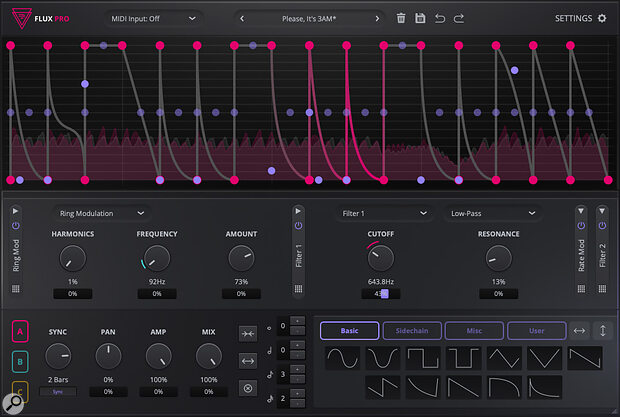Drawing some parallels with Cableguys’ ShaperBox series of plug‑ins, and perhaps overlapping with Output’s Movement and Logic Pro’s Step FX, Caelum’s Flux Pro is an affordable, easy‑to‑use, graph‑driven effects plug‑in which, despite its apparent simplicity, can produce some addictive rhythmic effects that completely transform the source material. It runs on Mac OS, Windows and iOS hosts that support the VST3, AU, AAX or AUv3 plug‑in formats.
Flux Pro’s operation is based on three graphs that can be sync’ed to a time grid and then used to control four effects slots, into each of which can be loaded one of 10 modulation effects, including basic level modulation. Any or all of the effect parameters can be controlled by the graphs, which can be constructed with straight lines and Bézier curves, and sync’ed to a tempo grid, the outcome of which is to add a rhythmic effect or perhaps sync’ed effects sweeps to whatever’s fed in, be it a drum loop or a continuous drone or pad.
Ready‑made shapes (there are 48 of these) can be dragged directly onto the graphs, after which they can be further edited and saved in the User Bank if you don’t want to build your own shapes from scratch. It is also possible to use MIDI triggering, both single‑shot and retriggering, to initiate the modulations, and the graph shapes can be output as MIDI CCs to control other plug‑ins or devices. If you have a DC‑coupled audio interface, you can also output the graphs as CV information to control modular synths. Logic Pro X users will find the plug‑in both in the Audio FX and MIDI Controlled Effects listings.
To get started, there are 115 presets, arranged by instrument and style, and the in‑built effects are Filter 1, Filter 2, Delay, Delay (Fixed), Width, Phaser, Chorus/Flanger, Rate Modulation, Ring Modulation and Utility. The filters include formant modes. It’s possible to create reverse‑like effects, pitched up or down by as much as an octave, by controlling the Fixed Delay effect from a graph. And there’s also an external sidechain input, so that the processing can be made to respond to a signal from another track. Offset buttons allow the graphs to be offset by a choice of musical measures.
The top section of the screen is given over to the graphs, and coloured selection buttons at the bottom left of the GUI are used to select graph A, B or C. A pulsing neon light follows the graph’s path, with red nodes for position adjustment and blue nodes for creating curves. In the mid section of the screen, two of the four effects slots can be viewed at any one time, each having a sensibly modest number of controls. The percentage bar below each dial is used to set the amount of modulation from the current graph, with a yellow line appearing round the controls to show the range of modulation.
At the bottom right are the preset modulation shapes, which can be reversed or flipped vertically. In fact, the only trick I felt was missing is that you don’t see the effect of parameter modulation in the lines around the controls, as you do in some plug‑ins.
I love the considered approach of Flux Pro, which strikes a good balance between simplicity of operation and sonic flexibility.
If you need more sophistication, then there’s no arguing that you’ll find more scope using ShaperBox 3, but I love the considered approach of Flux Pro, which strikes a good balance between simplicity of operation and sonic flexibility. The range of effects is impressively wide and it’s easy to come up with results that sound musical. The cost is very modest too, so it’s definitely worth a closer look. You can also check out Caelum’s free ‘taster’ version, Flux Mini 2, which offers similar control over the level and a high‑, low‑ or band‑pass filter.


